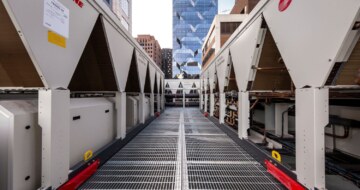
December 1, 2025 in Advisory Notes
Combating High Humidity in Commercial Buildings
High humidity is one of the more challenging and persistent issues facing commercial buildings today. Longer humid spells, warmer temperatures and mor...
November 10, 2025
This moves beyond traditional financial reporting by requiring forward-looking information on climate resilience, emissions, transition plans, and governance. The built environment and building operations can play a significant role in this reporting regime for many businesses.
This Advisory Note provides an overview of the new reporting requirements and offers a practical approach to address building related risk assessment and management.
Climate change is one of the major threats facing humanity worldwide. Australia is highly vulnerable to climate extremes, including extreme temperatures, bushfires, torrential rain, flooding and sea level rise.
The Commonwealth Government’s 2023 Intergenerational Report (IGR 2023) identified climate change as one of the five key forces that will impact and shape the Australian economy over the next four decades.
As part of a plan to address this challenge, the federal government has legislated mandatory climate-related financial disclosure reporting for large businesses and financial institutions, starting 1 January 2025 for the largest1 entities. Building asset owners and managers have a significant role to play in future-proofing building assets from the impacts of
climate extremes.
The AASB S2 standard, developed by the Australian Accounting Standards Board (AASB), details reporting requirements for an entity to disclose any climate-related risks and opportunities (CRROs) that could reasonably be expected to affect the entity’s cash flows, access to finance or cost of capital over the short, medium or long term.
Under AASB S2, a reporting entity’s buildings are part of the CRRO analysis, the outcome of which must be disclosed in their Sustainability Report.
The information required to be disclosed as part of the reporting, as relevant to the building or asset level, is summarised below.

A Climate-Related Risk Assessment is a process that determines whether climate change effects will impact a building or asset, and if so, the scale of the impact. The four key steps in this process are summarised below:

A vulnerability assessment is the first pass check that determines whether a building or an asset is physically located in a high-risk zone. The process involves scenario analysis5 based on future climate projection data from regional climate modelling across multiple emission scenarios and periods.
This is followed by a risk screening process, which determines the risk type based on the timeline of impact. This involves a rigorous analysis of various physical and operational parameters, classifying the risk into Type-1 (immediate action required), Type-2 (monitor and re-assess) and Type-3 (no action required). An entity must constantly re-evaluate the risks as the climate system is highly dynamic.
An entity also needs to identify risks beyond the boundary of the building. Success lies in identifying the risks that eventuate from external factors, which are equally vulnerable to climate change, and which the entity has no control over. The process of mapping both the internal and external risks is termed as risk categorisation and is graphically depicted as a risk disk as illustrated in Figure 2.
The final step in the risk management process is to classify the risk based on the severity of its potential impact (moderate / catastrophic / minor) and representing this in a risk matrix. This process should also analyse if a risk is a single event or recurrent, noting that the scale of impact or damage or recurrent risks can be significant.

Robust climate resilience must be a proactive approach and should develop strategies that meet short-term needs and long-term planning. The longer the resilience strategy implementation is delayed, the more expensive and ineffective the process will be. For effective implementation, climate change must be a mainstream factor in the decision-making, budgeting and operations of assets and services.
Combining a resilience strategy along with low emissions and Net Zero goals is an efficient pathway for asset owners. Some of the practical resilience strategies for building services are noted below:
Climate change is not a phenomenon of the future, and achieving Net Zero alone is not enough to shield your organisation from the impacts of
climate extremes.
Early intervention and adoption of risk management and a targeted resilience strategy across all vulnerable building assets and related services are key to preventing financial losses, reputational damage, hefty insurance premiums and stranded assets.

For further guidance on Mandatory Climate Reporting and the Role of Buildings, please contact:
Rakesh Ravichandran
Senior Engineer, Sustainability
A.G. Coombs Advisory
+61 447 602 739
rravichandran@agcoombs.com.au
1 A entity that satisfies 2 out of the 3 following criteria: Revenue > $500M, Gross assets > $1B, Employees > 500.
2 From the second year of reporting, Scope 3 emissions are also required to be reported.
3 Shadow pricing is a method used in financial analysis to estimate the potential cost of carbon emissions, even when there isn’t a direct market price for them. This will guide investment decisions and assessment of climate-related risks for an entity.
4 Internal carbon fees are a mechanism where companies assign monetary value to their greenhouse gas emissions, effectively treating them as a cost to be factored into business decisions.
5 Scenario Analysis is a method used to explore the potential impacts of climate change on an organisation or system by evaluating its performance under different future climate conditions.
Loading ratings...

December 1, 2025 in Advisory Notes
High humidity is one of the more challenging and persistent issues facing commercial buildings today. Longer humid spells, warmer temperatures and mor...

October 8, 2025 in Advisory Notes
Electrification projects can be complex undertakings bringing together a range of technical elements along with planning, coordination and logistics c...

September 1, 2025 in Advisory Notes
Cyber security incidents reported against both government and private organisations continue to increase in both frequency and severity.

July 15, 2025 in Advisory Notes
During COVID-19 many buildings experienced a significant reduction in the number of occupants. With the move to remote working, the reliance on tenant...